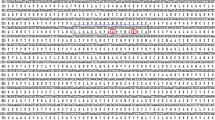Abstract
Phytophthora is considered one of the most destructive genus for many agricultural plant species worldwide, with a strong environmental and economic impact. Phytophthora cinnamomi is a highly aggressive Phytophthora species associated with the forest decline and responsible for the ink disease in chestnut trees (Castanea sativa Miller), a culture which is extremely important in Europe. This pathogenicity occurs due to the action of several enzymes like the hydrolysis of 1,3-β-glucans at specific sites by the enzyme endo-1,3-β-d-glucosidase. The aim of this work to analyze the heterologous expression in two microorganisms, Escherichia coli and Pichia pastoris, of an endo-1,3-β-d-glucosidase encoded by the gene ENDO1 (AM259651) from P. cinnamomi. Different plasmids were used to clone the gene on each organism and the real-time quantitative polymerase chain reaction was used to determine its level of expression. Homologous expression was also analyzed during growth in different carbon sources (glucose, cellulose, and sawdust) and time-course experiments were used for endo-1,3-β-d-glucosidase production. The highest expression of the endo-1,3-β-d-glucosidase gene occurred in glucose after 8 h of induction. In vivo infection of C. sativa by P. cinnamomi revealed an increase in endo-1,3-β-d-glucosidase expression after 12 h. At 24 h its expression decreased and at 48 h there was again a slight increase in expression, and more experiments in order to further explain this fact are underway.





Similar content being viewed by others
References
Erwin DC, Ribeiro OK (1996) Phytophthora diseases worldwide. American Phytopathological Society Press, St. Paul
Knogge W (1998) Fungal pathogenicity. Curr Opin Plant Biol 1(4):324–328
Hardham AR (2005) Phytophthora cinnamomi. Mol Plant Pathol 6(6):589–604
King M, Reeve W, Van der Hoek MB, Williams N, McComb J, O’Brien PA, Hardy GE (2010) Defining the phosphite-regulated transcriptome of the plant pathogen Phytophthora cinnamomi. Mol Genet Genomics 284(6):425–435
Birch PR, Rehmany AP, Pritchard L, Kamoun S, Beynon JL (2006) Trafficking arms: oomycete effectors enter host plant cells. Trends Microbiol 14(1):8–11
Ellis J, Catanzariti AM, Dodds P (2006) The problem of how fungal and oomycete avirulence proteins enter plant cells. Trends Plant Sci 11(2):61–63
Kamoun S (2007) Groovy times: filamentous pathogen effectors revealed. Curr Opin Plant Biol 10(4):358–365
Schornack S, Huitema E, Cano LM, Bozkurt TO, Oliva R, Van Damme M, Schwizer S, Raffaele S, Chaparro-Garcia A, Farrer R, Segretin ME, Bos J, Haas BJ, Zody MC, Nusbaum C, Win J, Thines M, Kamoun S (2009) Ten things to know about oomycete effectors. Mol Plant Pathol 10(6):795–803
Kamoun S (2003) Molecular genetics of pathogenic oomycetes. Eukaryot Cell 2(2):191–199
Attard A, Gourgues M, Galiana E, Panabieres F, Ponchet M, Keller H (2008) Strategies of attack and defense in plant–oomycete interactions, accentuated for Phytophthora parasitica Dastur (syn. P. Nicotianae Breda de Haan). J Plant Physiol 165(1):83–94
Day B, Graham T (2007) The plant host pathogen interface: cell wall and membrane dynamics of pathogen-induced responses. Ann N Y Acad Sci 1113:123–134
Kamoun S, Huitema E, Vleeshouwers VG (1999) Resistance to oomycetes: a general role for the hypersensitive response? Trends Plant Sci 4(5):196–200
Shibuya N, Minami E (2001) Oligosaccharide signalling for defense responses in plant. Physiol Mol Plant Pathol 59:223–233
Cosio EG, Feger M, Miller CJ, Antelo L, Ebel J (1996) High-affinity binding of fungal β-glucan elicitors to cell membranes of species of the plant family Fabaceae. Planta 200:92–99. https://doi.org/10.1007/bf00196654
McLeod A, Smart CD, Fry WE (2003) Characterization of 1,3-beta-glucanase and 1,3;1,4-beta-glucanase genes from Phytophthora infestans. Fungal Genet Biol 38(2):250–263
Esquerré-Tugayé M-T, Boudart G, Dumas B (2000) Cell wall degrading enzymes, inhibitory proteins, and oligosaccharides participate in the molecular dialogue between plants and pathogens. Plant Physiol Biochem 38:157–163. https://doi.org/10.1016/s0981-9428(00)00161-3
Vidhyasekaran P (2007) Fungal pathogenesis in plants and crops: molecular biology and host defense mechanisms, 2nd edn. CRC Press, Boca Raton
Meirinho S, Carvalho M, Domínguez A, Choupina A (2010) Isolation and characterization by asymmetric PCR of the ENDO1 gene for glucan endo-1,3-B-D-glucosidase in Phytophthora cinnamomi associated with the ink disease of Castanea sativa Mill. Braz Arch Biol 53(3):513–518
Raeder U, Broda P (1985) Rapid preparation of DNA from filamentous fungi. Lett Appl Microbiol 1(1):17–20
Hanahan D (1983) Studies on transformation of Escherichia coli with plasmids. J Mol Biol 166(4):557–580
Martins IM, Martins F, Belo H, Vaz M, Carvalho M, Cravador A, Choupina A (2014) Cloning, characterization and in vitro and in planta expression of a glucanase inhibitor protein (GIP) of Phytophthora cinnamomi. Mol Biol Rep 41:2453. https://doi.org/10.1007/s11033-014-3101-1
Murfett J, Wang XJ, Hagen G, Guilfoyle TJ (2001) Identification of Arabidopsis histone deacetylase HDA6 mutants that affect transgene expression. Plant Cell 13(5):1047–1061
Horta M, Sousa N, Coelho AC, Neves D, Cravador A (2009) In vitro and in vivo quantification of elicitin expression in Phytophthora cinnamomi. Physiol Mol Plant Pathol 73:48–57
Staskawicz BJ (2001) Genetics of plant–pathogen interactions specifying plant disease resistance. Plant Physiol 125(1):73–76
Shiraishi T, Yamada T, Ichinose Y, Kiba A, Toyoda K (1997) The role of suppressors in determining host–parasite specificities in plant cells. Int Rev Cytol 172:55–93
Rose JK, Ham KS, Darvill AG, Albersheim P (2002) Molecular cloning and characterization of glucanase inhibitor proteins: coevolution of a counterdefense mechanism by plant pathogens. Plant Cell 14(6):1329–1345
Author information
Authors and Affiliations
Corresponding author
Ethics declarations
Conflicts of interest
The authors declare that there are no conflicts of interest. Also, are indebted to the careful and constructive criticisms of the reviewers.
Additional information
Publisher's Note
Springer Nature remains neutral with regard to jurisdictional claims in published maps and institutional affiliations.
Rights and permissions
About this article
Cite this article
Costa, R., Domínguez, A. & Choupina, A. Cloning and expression analysis of an endo-1,3-β-d-glucosidase from Phytophthora cinnamomi. Mol Biol Rep 47, 935–942 (2020). https://doi.org/10.1007/s11033-019-05185-9
Received:
Accepted:
Published:
Issue Date:
DOI: https://doi.org/10.1007/s11033-019-05185-9




